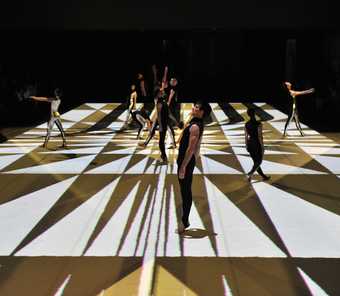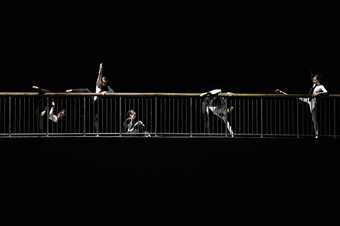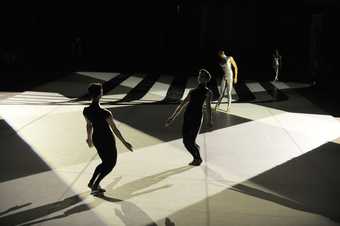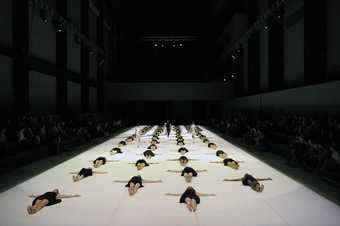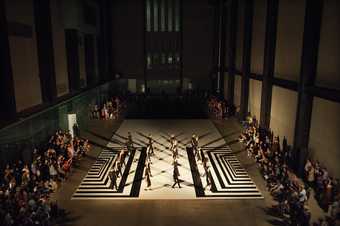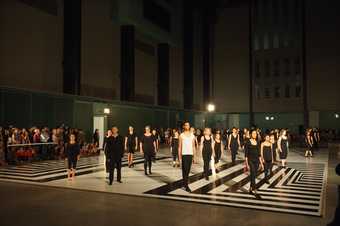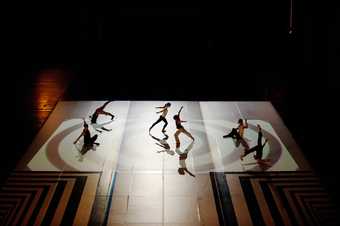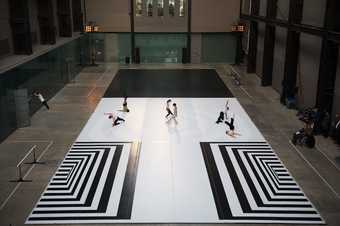In 2010 Tate invited British choreographer Michael Clark and his dance company to undertake a seven-week residency at Tate Modern between 13 July and 30 August. The company rehearsed in the Turbine Hall each day, allowing visitors to see the usually hidden process of choreographic development and rehearsal. Influenced by Yvonne Rainer, who has also worked extensively with untrained dancers, Clark felt a participatory piece involving both trained and untrained dancers would fit well in the public space of the Turbine Hall. Clark devised a piece of mass choreography with ‘non dancers’, which was integrated into the final public performance given by his company in the final week of the residency. Clark returned again in 2011, for the performance of a new production, th, which ran between 8–12 June 2011. This production built on the research he undertook in 2010 and continued the collaboration between his own company and non-dancers selected via an open call process.
The 2010 residency can be understood as a laboratory phase. An open call was advertised on the Tate website in 2009 from which seventy-eight people were selected on a first-come, first-served basis. The only prerequisite was to have had no formal training. The main company would rehearse in the Turbine Hall space daily, but Clark worked with the members of the public weekly on Friday nights. The non-dancers learned a different set of movements and although they took part in the same performance as the company, they had their own individual scenes performed in a concentrated area whereas the professionals made use of the entire space. The non-dancers outweighed the company dancers, which identified them from each other. Clark’s integration of non-dancers gestured to his influence on and participation in punk culture as well as to the articulation of a democratic space for dance. This was underscored by Clark’s occupation of the Turbine Hall throughout the residency, which allowed visitors to encounter the work unexpectedly, rather than only presenting a finished work at a ticketed event.
The choreography rehearsed and performed in 2010 paired the rigour of classical steps with contemporary movement, a juxtaposition that paralleled Clark’s training as a ballet dancer at the Royal Ballet, and his later anti-hierarchical, anti-authoritarian choreographic experiments. Balletic poses, jumps and steps were isolated from traditional narrative sequences and made strange through repetition. The graceful leaps and turns of the trained dancers seemed awkward and uneven, just as they were often out of sync and oriented in different directions. This choreography paralleled the performance space, which was demarcated by geometric and striped floor mats designed by Charles Atlas, which resembled the large windows at the back of the hall and the black beams that extend vertically from floor to ceiling. The audience sat on the floor around the mats and watched from the balconies and upper floors. Atlas also designed the lighting for the performance, highlighting the long-term collaboration between the two men. The residency accentuated what Clark saw as the Turbine Hall’s ‘inbetweenness’; his choreography along with Atlas’s contributions represented the blending of public and private space.
The run of performances from 8 to 12 June 2011, titled th, was another site-responsive work, which drew on ideas developed in the 2010 residency. The title signified Clark’s interest in ‘inbetweenness’: the ‘t’ and ‘h’ relate to the first letters of the words Turbine Hall brought together through a diphthong (the merging of the two sounds ‘t’ and ‘h’). th emphasised the Turbine Hall’s physical situation as the threshold between the space of art and the world beyond the museum’s walls. Using the same procedure as in 2010, Clark’s company ran another open call for non-dancers to rehearse with them weekly over six weeks. These rehearsals were not public, but nonetheless provided an opportunity for non-professional dancers to witness the artistic process behind Clark’s methods. In the final performance his punk sensibilities were evident again in the inclusion of pop and rock songs by David Bowie, Kraftwerk and Pulp. In grid-like formation, the non-dancers learnt a mechanical step routine to Bowie’s 1980 track It’s No Game. Fashion designer Stevie Stewart dressed the non-dancers in black asymmetric drapes, singling them out from the professionals, who wore leotards, in a palette of black, white and gold. This colour scheme was mirrored in Atlas’s custom projections and lighting, which cast constellations of black, white and gold geometric and spiral patterns onto the floor as if following the performers through the space. The audience sat in staggered block seating on three sides of the ground floor, peering down on the performance, the majority of which took place on mats, apart from a section on the Turbine Hall’s upper bridge. In this piece the Turbine Hall became a kinetic sculpture, animated by the bodies performing within it, and emphasising the relationship between public architecture, the body and human movement.
Philomena Epps
February 2016

